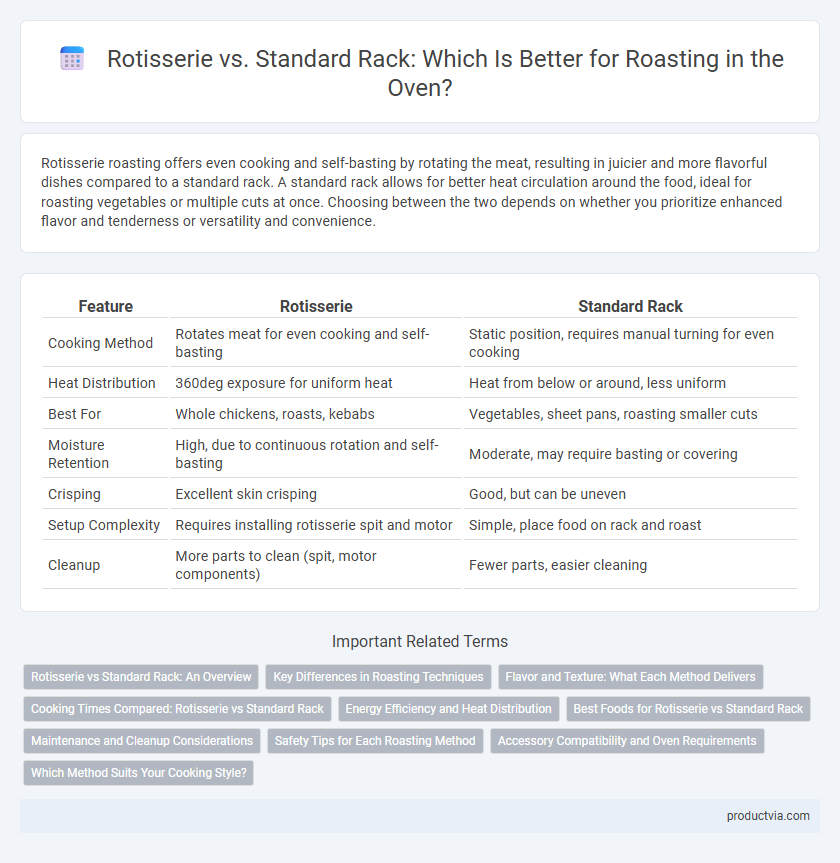Rotisserie roasting offers even cooking and self-basting by rotating the meat, resulting in juicier and more flavorful dishes compared to a standard rack. A standard rack allows for better heat circulation around the food, ideal for roasting vegetables or multiple cuts at once. Choosing between the two depends on whether you prioritize enhanced flavor and tenderness or versatility and convenience.
Table of Comparison
| Feature | Rotisserie | Standard Rack |
|---|---|---|
| Cooking Method | Rotates meat for even cooking and self-basting | Static position, requires manual turning for even cooking |
| Heat Distribution | 360deg exposure for uniform heat | Heat from below or around, less uniform |
| Best For | Whole chickens, roasts, kebabs | Vegetables, sheet pans, roasting smaller cuts |
| Moisture Retention | High, due to continuous rotation and self-basting | Moderate, may require basting or covering |
| Crisping | Excellent skin crisping | Good, but can be uneven |
| Setup Complexity | Requires installing rotisserie spit and motor | Simple, place food on rack and roast |
| Cleanup | More parts to clean (spit, motor components) | Fewer parts, easier cleaning |
Rotisserie vs Standard Rack: An Overview
Rotisserie roasting provides even heat distribution and self-basting, resulting in juicier, more flavorful meat compared to the standard rack method. Standard racks allow for easier access and can accommodate a variety of food sizes but may require manual basting and rotating to achieve similar results. Choosing between rotisserie and standard racks depends on the desired texture, flavor, and convenience during roasting.
Key Differences in Roasting Techniques
Rotisserie roasting involves slow, even rotation of meat on a spit, ensuring uniform heat distribution and self-basting, which results in juicier, more flavorful dishes. Standard racks hold meat stationary, relying on radiant heat from the oven, which can lead to less consistent cooking and dryer edges unless manually basted. Rotisserie excels for whole chickens and large cuts, while standard racks are versatile for various roasting tasks, offering easier accessibility and cleanup.
Flavor and Texture: What Each Method Delivers
Rotisserie roasting circulates heat evenly around the meat, resulting in a uniformly crispy exterior and juicy interior that locks in natural flavors. Standard rack roasting allows for better browning on the bottom surface but may require manual rotation to achieve consistent texture and flavor throughout. The rotational method enhances self-basting, intensifying savory notes, while the rack method offers more control over drip and smoke, contributing to a different but desirable flavor profile.
Cooking Times Compared: Rotisserie vs Standard Rack
Rotisserie cooking typically requires longer cooking times than a standard rack due to the slow, even rotation that ensures thorough heat circulation and caramelization. Standard racks allow hot air to surround the meat, often resulting in faster cooking but potentially less even browning. Understanding these differences can help optimize roasting results based on desired texture, juiciness, and timing.
Energy Efficiency and Heat Distribution
Rotisserie roasting typically offers more even heat distribution by continuously rotating food, which can reduce cooking time and energy consumption compared to a standard rack. Standard racks rely on static heat exposure, potentially causing uneven cooking and requiring longer oven usage, thus increasing energy use. Choosing rotisserie mode enhances energy efficiency by maximizing heat circulation and minimizing hot and cold spots inside the oven.
Best Foods for Rotisserie vs Standard Rack
Rotisserie roasting excels with whole chickens, large cuts of meat like prime rib, and sausages, as the constant rotation ensures even cooking and crispy skin. Standard racks work best for vegetables, smaller cuts of meat such as pork chops, and baked goods where steady heat and easy access are needed. Choosing the right method depends on the food's size, shape, and texture to achieve optimal flavor and texture.
Maintenance and Cleanup Considerations
Rotisserie attachments typically require more maintenance due to grease buildup on the spit and forks, necessitating frequent cleaning to prevent residue and odors. Standard racks are easier to clean, often dishwasher-safe, and accumulate less drippings, resulting in simpler and quicker maintenance. Choosing between a rotisserie and a standard rack influences the overall ease of cleanup and frequency of detailed cleaning sessions.
Safety Tips for Each Roasting Method
Rotisserie roasting requires securing the meat firmly on the spit to prevent slipping and potential burns, while maintaining a safe distance from rotating parts during operation. Standard rack roasting demands evenly spaced placement to ensure proper air circulation and prevent tipping, with oven mitts used carefully to avoid contact with hot surfaces. Both methods benefit from frequent temperature checks and keeping the oven door closed to maintain heat and reduce the risk of accidents.
Accessory Compatibility and Oven Requirements
Rotisserie attachments require specific oven dimensions and motor compatibility to ensure smooth rotation and even cooking, limiting their use to ovens with adequate clearance and power supply. Standard racks offer broader accessory compatibility, fitting most oven models regardless of size or electrical specifications, making them more versatile for typical roasting needs. Users should verify oven interior space and accessory specifications before choosing between a rotisserie or standard rack for optimal roasting performance.
Which Method Suits Your Cooking Style?
Rotisserie roasting evenly cooks meat by slowly rotating it, ideal for achieving crispy skin and juicy, tender results, especially with whole chickens or roasts. Standard racks provide static heat, offering more versatility for roasting vegetables, multiple cuts of meat, or when a crisp crust is desired through different oven placements. Choose rotisserie for consistent, hands-off cooking with a focus on poultry or roasts and standard racks for greater control over diverse ingredients and browning techniques.
Rotisserie vs Standard rack for roasting Infographic

 productvia.com
productvia.com